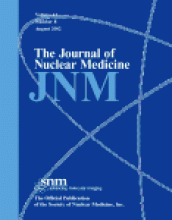The article by Shi et al. (1) in this issue of The Journal of Nuclear Medicine is potentially very important. It holds out the promise of a specific radiologic aid in the diagnosis of Alzheimer-type dementia. Shi et al. succeeded in using ligands introduced intranasally to label Alzheimer-type amyloid in the brains of transgenic mice. The same ligands were too large to enter the brain when administered systemically. These data raise the possibility of labeling Alzheimer plaques in living patients with radioactive ligands. In principle, doing so could allow quantification of the amount of Alzheimer plaque material present in patients undergoing diagnostic work-up. The intranasal route described by Shi et al. might even be readily adaptable to the use of labeled antibodies, including purified monoclonal antibodies specific to particular epitopes in amyloid or to other structures of interest in Alzheimer brain such as neurofibrillary tangles.
The point of quantitating Alzheimer plaques in living patients is that those lesions, by definition, are diagnostic of Alzheimer’s disease. A demented patient with an appropriate density of neuritic amyloid plaques in his or her brain has Alzheimer’s disease; an equally demented patient without those lesions does not have Alzheimer’s disease, by consensus definition (2). The most direct biologic test to establish or disprove the diagnosis of Alzheimer’s disease is to measure the amount of neuritic amyloid plaque material present in a demented patient’s brain. Up to now, this can be done reliably only at autopsy. A radiologic procedure to do so would allow this critical determination during life, while an accurate diagnosis can still influence the care of the patient. Clearly, much further work will be needed before the use of intranasal ligands for Alzheimer amyloid reaches general clinical usefulness. One problem is that the dose of radiation needed may be excessive, particularly if a longer-lived γ-emitter is bound to stable amyloid plaques. Positron emitters may prove safer. Despite anticipated problems, the paper by Shi et al. (1) opens fascinating, exciting possibilities for improving the diagnosis of this common disabling disease of the elderly.
A successful clinical adaptation of this method is likely to detect Alzheimer amyloid plaques in people who have no significant mental disability. Autopsy-controlled series over the last 20 y have consistently shown the presence of significant numbers of neuritic amyloid plaques in people who appear entirely intact clinically. One recent example is the Nun Study (3). A striking example is “Sister Mary.” She died at 101 y old, intellectually intact on detailed testing. At autopsy, her brain was full of amyloid plaques and clearly met consensus criteria for the neuropathologic diagnosis of Alzheimer’s disease (3). Another recent example is an autopsy-controlled epidemiologic study in Finland (4). Among people ≥85 y old, 33% met the neuropathologic criteria for Alzheimer’s disease but only 16% were demented clinically (4). There is some selection in who has an autopsy. It is possible, although unlikely, that studies of large series of living people will disagree with the results of the autopsy-controlled series.
Specific neuroradiologic studies of Alzheimer amyloid will probably raise the question of what should be done with people who have cerebral amyloidosis but are not clinically ill. Many physicians are convinced that Alzheimer amyloid is the pivotal event in Alzheimer’s disease—that is, they hold to the amyloid cascade hypothesis. They believe that asymptomatic people with Alzheimer amyloidosis are in a preclinical phase of Alzheimer’s disease (5). Others have pointed out that increased production of the amyloid precursor protein is a response of the brain to many types of injury, and this response is more likely to have evolved to protect brain rather than to harm it. Analogous to inflammation, increased production of amyloid precursor protein may start out as a protective response but eventually become harmful. These unsettled issues have been discussed in detail (5,6).
Elsewhere, I have used the term “Alzheimer’s disease” to refer to the neuropathologic state and the term “Alzheimer’s dementia” to refer to clinical dementia in people who have concomitant, neuropathologic Alzheimer’s disease (6). By this terminology, perhaps twice as many people have Alzheimer’s disease as have Alzheimer’s dementia. A radiologic procedure to detect Alzheimer’s disease will allow objective, prospective clinical trials to determine whether people who are clinically well but have a significant burden of Alzheimer amyloid in their brains should be treated (6).
The article by Shi et al. (1) holds great promise. If further studies bear out that promise, then the techniques they are introducing may well have major implications for our ability to understand, treat, and perhaps even prevent Alzheimer’s dementia.
Footnotes
Received Feb. 25, 2002; revision accepted Mar. 25, 2002.
For correspondence or reprints contact: John P. Blass, MD, PhD, Dementia Research Service, Burke Medical Research Institute, 785 Mamaroneck Ave., White Plains, NY 10605.
E-mail: jpblass{at}med.cornell.edu







